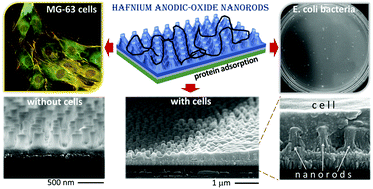Anodic formation and biomedical properties of hafnium-oxide nanofilms
Abstract
Hafnium dioxide (HfO2) is attracting attention for bio-related applications due to its good cytocompatibility, high density, and resistance to corrosion and mechanical damage. Here we synthesize two types of hafnium-oxide thin films on substrates via self-organized electrochemical anodization: (1) an array of hierarchically structured nanorods anchored to a thin oxide layer and (2) a microscopically flat oxide film. The nanostructured film is composed of a unique mixture of HfO2, suboxide Hf2O3, and oxide-hydroxide compound HfO2·nH2O whereas the flat film is mainly HfO2. In vitro interaction of the two films with MG-63 osteoblast-like cells and Gram-negative E. coli bacteria is studied for the first time to assess the potential of the films for biomedical application. Both films reveal good cytocompatibility and affinity for proteins, represented by fibronectin and especially albumin, which is absorbed in a nine times larger amount. The morphology and specific surface chemistry of the nanostructured film cause a two-fold enhanced antibacterial effect, better cell attachment, significantly improved proliferation of cells, five-fold rise in the cellular Young's modulus, slightly stronger production of reactive oxygen species, and formation of cell clusters. Compared with the flat film, the nanostructured one features the weakening of AFM-measured adhesion force at the cell/surface interface, probably caused by partially lifting the nanorods from the substrate due to the strong contact with cells. The present findings deepen the understanding of biological processes at the living cell/metal-oxide interface, underlying the role of surface chemistry and the impact of nanostructuring at the nanoscale.



 Please wait while we load your content...
Please wait while we load your content...